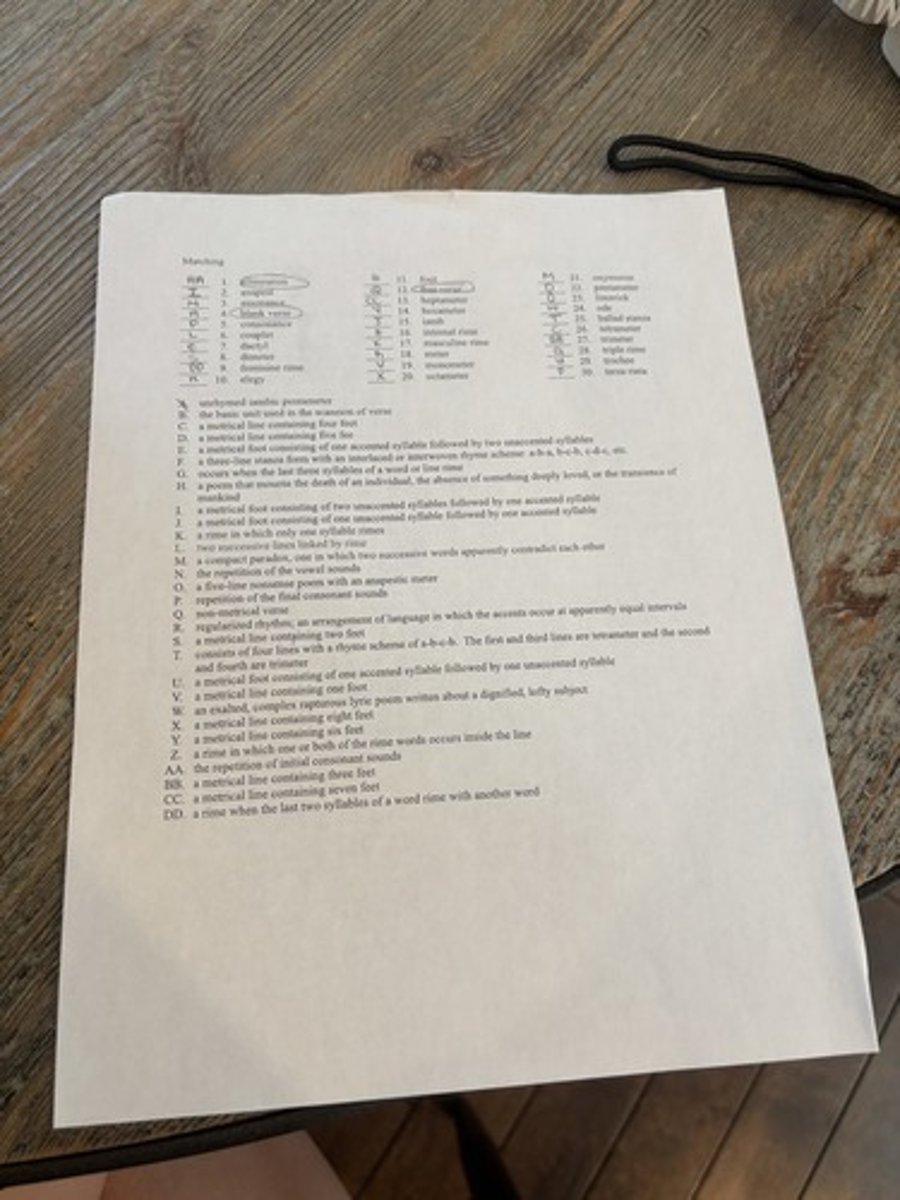AP English Literature Poetry Test Study Guide
1/52
There's no tags or description
Looks like no tags are added yet.
Name | Mastery | Learn | Test | Matching | Spaced |
|---|
No study sessions yet.
53 Terms
alliteration
the repetition of initial consonant sounds
anapest
a metrical foot consisting of two unaccented syllables followed by one accented syllable
blank verse
unrhymed iambic pentameter
assonance
the repetition of the vowel sounds
dactyl
a metrical foot consisting of one accented syllable followed by two unaccented syllables
elegy
a poem that mourns the death of an individual, the absence of something deeply loved, or the transience of mankind
consonance
repetition of the final consonant sounds
couplet
two successive lines linked by rime
dimeter
a metrical line containing two feet
masculine rime
a rime in which only one syllable rimes
hexameter
a metrical line containing six feet
iamb
a metrical foot consisting of one unaccented syllable followed by one accented syllable
internal rime
a rime in which one or both of the rime words occurs inside the line
limerick
a five-line nonsense poem with an anapestic meter
meter
regularized rhythm; an arrangement of language in which the accents occur at apparently equal intervals

monometer
a metrical line containing one foot
octameter
a metrical line containing eight feet
ode
an exalted, complex rapturous lyric poem written about a dignified, lofty subject
pentameter
a metrical line containing five feet
ballad stanza
consists of four lines with a rhyme scheme of a-b-c-b. The first and third lines are tetrameter and the second and fourth are trimeter
trimeter
a metrical line containing three feet
trochee
a metrical foot consisting of one accented syllable followed by one unaccented syllable
terza rima
a three-line stanza form with an interlaced or interwoven rhyme scheme: a-b-a, b-c-b, c-d-c, etc.
heptameter
a metrical line containing seven feet
triple rime
occurs when the last three syllables of a word or line rime
oxymoron
a compact paradox, one in which two successive words apparently contradict each other
personification
a figure of speech in which human attributes are given to an animal, object, or concept
antithesis
a figure of speech in which what is meant is the opposite of what is said
allusion
a reference, explicit or implicit, to something in previous history or literature or art
metonymy
the substitution of a word naming an object for another word closely associated with it
symbol
a figure of speech in which something (object, person, situation, or action) means more than what it is
allegory
a narrative or description having a second meaning beneath the surface one
paradox
a statement or situation containing apparently contradictory or incompatible elements
imagery
the representation through language of sense experience
metaphor
a figure of speech in which an implicit comparison is made between two things essentially unlike
simile
a figure of speech that makes a comparison between two different things using 'like' or 'as'
onomatopoeia
the use of words that supposedly mimic their meaning their sound
apostrophe
a figure of speech in which someone absent or dead or something non-human is addressed as if it were alive and present and could reply
synecdoche
a figure of speech in which some significant aspect or detail of an experience is used to represent the whole experience
overstatement
a figure of speech in which an exaggeration is used in the service of the truth
understatement
a figure of speech that consists of saying less than one means, or saying what one means with less force than the occasion warrants
verbal irony
a device by which the author implies a different meaning from that intended by the speaker in a literary work
dramatic irony
a situation in which the audience knows more about the circumstances than the characters do
irony of situation
a situation in which there is an incongruity between actual circumstances and those that would seem appropriate or between what is anticipated and what actually comes to pass
denotation
the basic definition or dictionary meaning of a word
connotation
what a word suggests beyond its basic definition, a word's overtones of meaning
hyperbole
a figure of speech in which exaggeration is used in the service of truth
simile
a figure of speech in which an explicit comparison is made between two things essentially unlike, using like, as, than, similar to, resembles, or seems
feminine rime
occurs when the last two syllables of a word or line rime
foot
the basic unit used in the scansion of verse
free verse
non-metrical verse
tetrameter
a metrical line containing four feet
triple rime
a rime in which the last three syllables of a word or line rime